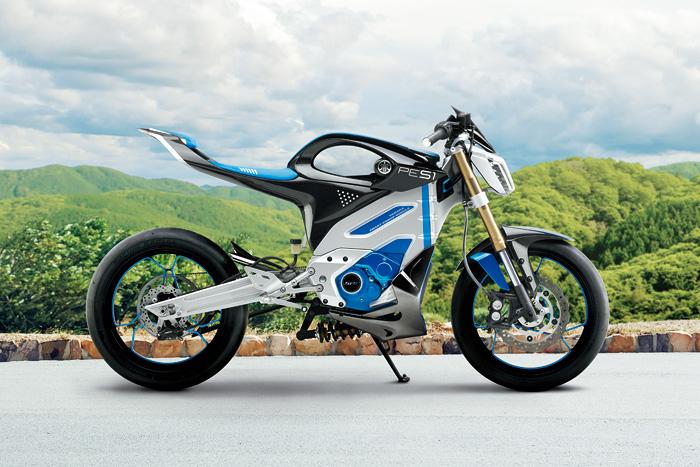
Just months after a concept electric motorcycle called the PES1 met with positive feedback at the 2013 Tokyo Motor Show, a new video suggests Yamaha may be working on bringing it to market.
Yamaha has posted several new videos of the PES1, which stand for “Passion Electric Street” according to the folks at Motorcycle Daily. Which, I assume, is probably not supposed to be pronounced “PEZ-one”. But I digress.
First, the looks: Clearly intended to convey a lightweight vibe, the hollowed-out tank and seat subsection combine with the barely-there wheels to turn the typically “dense” motorcycle aesthetic on its head. The battery is still a lump in the middle. Admittedly, though, it’s going to be a challenge for bike makers to style the big cubes into something sexy.
A double-sided LED headlight with bug screen from the Cylon school of industrial design lights the way forward, LED indicators will likely round out the rest if the PES1 makes it to production. Overall, the bike looks very finished although Yamaha labels it a prototype at the end of the videos. By my approximation, the bike seems to be a few mirrors and turn signals away from being road ready, however.

Clearly, this is a purpose-built city bike, as most electric bikes are by default due to range issues. It’s tiny, despite appearing to have at least 16 or 17-inch wheels. One shot of the PES1 coming head-on towards the camera with the rider all tucked in makes the bike appear only a bit more substantial than a burly mountain bike or a trials motorcycle.
Handling is another matter, however, as Yamaha shows the rider railing the PES1 through corners at full lean on a race track. Front forks are upside-down types with a single front disc grabbed by an R6/R1-type radial twin-piston caliper. A monoshock linkage system rides under the frame and battery box, which takes the place of a gas engine of course.
Yamaha hasn’t given any specs on battery capacity or motor output, but quick shots of a digital speedo show a top speed of 100 kph, or about 62 mph. But from the somewhat spindly looks of the machine, its doubtful riders are going to be doing battle with freeway traffic.
Slowing down the speedometer section of the video again reveals some interesting possibilities for the drive system. An “A” shows up at one point (most certainly for Automatic) and at another point, it shows a GEAR 4 on the display, indicating manual control of the gear ratios. Manual shifts are completed old-school style with the left boot, unlike the electro-thumbers Honda uses on their NC and CTX models.
Another interesting clue about the bike’s display is hidden in the videos: it’s a phone, an NTT Docomo X phablet specifically. We featured a local tech outfit here in Portland that did the same thing with a cyber-retro CB750 and an iPhone. Other manufacturers have also shown phone-as-display tech; we definitely think it’s a coming tech trend since it allows riders to use popular phone features such as GPS and also utilize new Bluetooth-equipped helmets for music, calls and voice-control features. And since the bike probably won’t run without the phone in place, once you walk away with the phone in your pocket, the bike is pretty much secure against hot-wire types of theft.
Will the PES1 make it to market? It looks close to production, but given designers’ tools such as rapid prototyping, CNC machining and now 3D printing of just about anything, it’s no longer a monumental effort to quickly put a nearly-ready looking prototype together.
If it does make it into production, it’s probably too small for the U.S. market as is, but it could be a hit in crowded Asian metropolises with their soaring fuel costs, tightening emissions and pollution problems.
I know I’d ride it, but I might have to wear a fez on top of my helmet.


